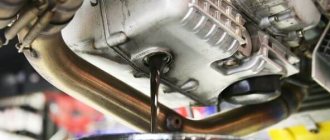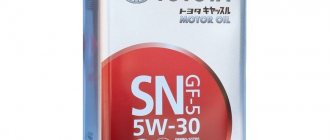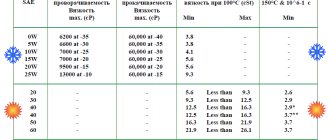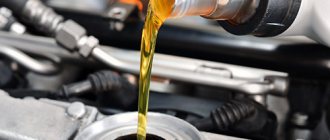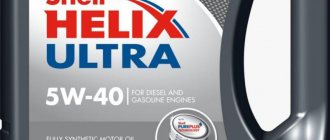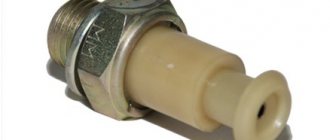Reasons for the emergence of counterfeit products
A large number of underground workshops engaged in counterfeiting oils of popular brands is explained by the following factors:
- Constantly growing demand for these products. The number of cars in Russia is increasing, and without oil an internal combustion engine cannot function. The used lubricant is periodically replaced with a new one, so there will always be a buyer for the counterfeit.
- The simplicity and low cost of producing such counterfeit goods.
Which oil is most often counterfeited?
In order to extract maximum profit, scammers counterfeit expensive oils from world brands, for example:
- Shell;
- Mobil;
- "Elf";
- Total;
- LUKOIL;
- "Zeke";
- GM;
- "Motul".
Preference is given to brands that produce products in plastic canisters. The production of such containers does not require expensive equipment; it is easy to make in artisanal conditions.
Oils supplied in metal containers are less likely to be adulterated. To produce such containers and apply images to them, a fleet of expensive equipment is required, which makes an underground workshop unprofitable.
Counterfeit motor oil exists for almost all brands.
Fraudsters can only buy empty canisters with lids from car service stations, which limits the volume of counterfeit goods.
Therefore, when purchasing oils of the following brands, the risk of running into a fake is significantly reduced:
- "Nissan";
- "Toyota";
- "Demitsu."
Checking Shell brand oil
A popular brand of motor oils in Russia. If you carefully watched the video of the operational shooting presented above, you probably saw those shots with counterfeit Shell oil. Naturally, there are still many such clandestine oil production in Russia. So the likelihood of buying counterfeit oil of this brand in our country is very high. Fortunately, it recently introduced another additional protection for its containers with motor oils.
Thus, a double sticker with several degrees of protection appeared on top of the canister cap:
Top layer of Shell oil cap sticker:
- 1. Four-Digit Numeric Code: The code number matches the last 4 digits of the barcode. Also, 4 digits are treated with a special compound, which allows the buyer to verify the authenticity of the oil. So, for example, if you moisten 4 numbers with water, they will turn red.
- 2. Holographic mesh paint that, when the viewing angle changes, changes color from green to gray.
- 3. A holographic animation image consisting of four icons:
Please note that the holographic icons change to a holographic “genuine” text depending on the viewing angle.
Also, the word “genuine” itself is immediately translated into several languages.
Inner layer of Shell oil sticker:
Under the main layer of the engine oil cap sticker there is a second sticker with a special code printed on it, with which you can find out on the Internet whether the can of oil in front of you is genuine or not.
On the second layer of the sticker you can see the following, namely, both the digital verification code itself via the Internet, and a QR code for checking the originality of the oil using a mobile phone.
And so, to check the authenticity of the engine oil, you must go to the web page: https://ac.shell.com/
Then, in the appropriate field, you must enter the 16-digit verification code, which is indicated on the second layer of the sticker on the lid of the engine oil can and located under the QR code.
After entering the code in the field, you need to click the “continue” button. As a result, you will get that engine oil test result. If the product is original, the system will inform you that the verification was completed successfully. This will mean that the product is genuine.
Attention! Please note that one code can be checked only 5 times. That is, checking using the same code for the sixth time will not be possible.
Among other things, we would also like to note that the sticker on the lid of the Shell oil canister is disposable. That is, by detaching the top layer and gaining access to the second layer of the sticker, where the oil authentication code is located, the sticker itself is inevitably damaged.
Therefore, remember, when purchasing Shell motor oil, pay attention to the integrity of the sticker on the cap, as well as to the absence of foreign traces of glue.
In particular, before purchasing, carefully inspect the container of this oil, namely for the integrity of the lid and its side stickers. The quality of printing must be high and not contain any spelling errors. Also remember that, according to current legislation, it labels all its motor oils supplied to the Russian market with labels translated into Russian. So we do not advise you to purchase Shell motor oil that does not have Russian language on the label.
How to understand that you have purchased low-quality motor oil
After pouring the surrogate into the engine, the following phenomena are observed:
- In cold weather it starts with great difficulty. This is due to the thickening of the lubricant.
- Oil consumption increases, the composition must be added more often. Due to non-compliance with operating parameters, it quickly burns out.
- The engine pulls worse and runs unevenly. Since the composition does not perform its functions well, friction between parts increases.
- During startup, the engine jerks and blue smoke comes out of it.
- Deposits appear on the parts. The reason is the low quality of additives or their absence.
- The motor gets hotter.
After filling the surrogate, oil consumption increases.
Even with minor suspicions, it is recommended to change the oil. Repairs will cost much more than purchasing an extra canister.
What to look for when purchasing
In order not to buy counterfeit products instead of quality ones, you need to carefully examine the product on offer. Fearing image and financial losses, auto chemical manufacturers are constantly introducing more and more complex anti-counterfeit elements.
Therefore, before going to the store, it is recommended to visit the manufacturer’s website and see what the canister with its oil now looks like. It is also useful to take with you an empty container from a previously purchased product, so that you have something to compare the product offered with.
Package
Signs of non-original origin of lubricant in a plastic canister are:
- A sharp chemical odor emanating from the polymer.
- The wall thickness is small, which is why the container is translucent.
- Burrs, cavities, bosses and other casting defects.
- Uneven seam at the junction of the 2 halves.
- Weak handle fastening.
- Not cast, but a painted measuring scale for determining the remainder.
- Faded label, possibly with errors. When lifted with a fingernail, it peels off easily and is glued unevenly. There are air bubbles.
- The dates of manufacture of the container (applied to the bottom) and production of the oil do not correspond to each other. The first must be earlier and identical to that indicated on the label.
- No mark with batch number and expiration date.
A sign of non-original oil is a label that peels off easily.
Branded lubricant is produced in containers without defects made of high-quality durable plastic. It shimmers in the light like metallic and may have inclusions. The label is bright, with rich colors, and is glued securely.
Counterfeit motor oil: no warranty
We won’t be far wrong if we say that at some point it began to seem to many of us (ordinary people not directly involved in the sales of motor oil) that those blessed times had come when, when buying lubricant, you don’t have to worry about its quality. After all, it seems that all other counterfeit products have decreased. Information trash like “Duty Unit” and similar TV hits no longer “nightmare” the consciousness as it did, say, a decade ago. Well, where, one might ask, is the massive cover-up by authorities of workshops producing counterfeit mayonnaise? Where are the “underground laboratories” that produce canned food, sausages, cheeses and other foodstuffs? If criminal business of this kind is not in favor now, then you certainly don’t have to worry about automobile oil.
Here we must understand that the central media, especially with their current priorities, are far from an objective assessment of reality. And the fact that stories about identifying manufacturers and sellers of counterfeit oil are not broadcast on TV channels does not mean at all that this is not happening. On the Internet, mainly with reference to the regional press and TV, you can find notes that in Tver, then in Kazan, then in Izhevsk and Kemerovo “they were identified, seized, fined.” True, we are usually talking about fairly insignificant volumes and amounts. But why then do people from the “oil industry” sometimes reluctantly, and sometimes absolutely openly say that there are a lot of fakes on the market?
There is one more fundamental nuance in covering cases of counterfeit detection. The oil giants themselves are not inclined to make such facts public. Unlike the same automakers who admit the existence of recall campaigns (in fact, defects), these ones observe a “mode of silence.” Although, in fact, they have nothing to do with fakes. What can I say, the concerns are European, but the approach is purely Russian - to hide, keep quiet, pretend that everything is in order. You can even hear the following from some representatives: “We deliberately do not inform the buyer on a large scale about the differences between original and counterfeit packaging - so as not to inform scammers about our methods of protection against them.”
Meanwhile, enterprising people from those for whom any income is good and who are able to carry out production, seem to know the subject of their copying by heart. And they are constantly improving. And the canister itself (we mean the original product), partly thanks to these same people, has recently undergone a number of “plastic surgeries.” Received an intricate shape, measuring scale, double-sided label. Someone else has a hologram or, for example, a manufacturer's logo on the lid. This is not to mention the things that have already become familiar - high-quality printing and stickers of paper, a protective ring, plastic that is smooth to the touch and appearance, and casting without flash. In general, the life of counterfeiters is not easy.
The evolution of canisters from a natural, in the truest sense of the word, can of the world’s first Valvoline motor oil (left) to domestic packaging (right) - still without any security elements, which was counterfeited by everyone and everything. By the way, the tin canister (in the center) used to be distributed throughout the world. Now it is also popular, for example, among Asian manufacturersJust a year and a half ago this was clearly noticeable. The canisters from the “underground” were distinguishable from a distance. On the “chapped” plastic, a crookedly stuck label that bubbled and peeled off at the edges. And also by the absence of a “not for food” sign, by the lid that was removed along with the ring, and by the foil membrane that barely stayed on the neck. Yes, along the neck itself, which, being pulled out, “stuck” in counterfeit canisters. And if the last things (lid, membrane, neck) could only be checked by purchasing the oil, then everything else was visible to the naked eye. There were also fundamental differences “by brand” related to the technological level that the scammers were able to achieve. For example, in the Mobil and Shell canisters we encountered, the plastic had a granular structure. The plastic of the Castrol container was smooth, but the hologram changed color in spots. In a word, who knows what.
The plastic structure of some fake canisters is rough. A very clear indication of the “left” origin of the container and contents
This photo shows how different the plastic of the original (in the background) and counterfeit canisters can be
It happens that the lid cracks - also an obvious sign that we are dealing with a non-original product
The membrane on the neck is another thing that “alternative manufacturers” stumble over. If this is found under the lid, you should at least think about using oil.
Unfortunately, recently a counterfeit product has appeared on the market, whose “wrapper” almost completely replicates the original one. The label has become double, a normal lid is used, even the quality of the plastics, or rather the casting, has reached an optimal level. “Officials” note that it is now extremely difficult to distinguish a fake. What helps, at least for now, is the so-called batch code - batch code, or batch number. Namely, a series of numbers and letters indicating the date and time of issue. It is applied at the bottom of the canister using something like a printer and for some reason it is a problem for scammers. The characters may not always be clear, and they also vary in length.
An example of the difference between batch codes. On the left is a fake - a short line with an abstract set of numbers and no date/time
The fact that this canister, and especially the oil in it, was not produced at the Shell plant is immediately obvious. Alas, over the past year, scammers have become very adept at creating much higher quality plastic products that almost replicate the original ones.
Sometimes a fake can be distinguished by a measuring scale that has some defects. In this case, on the canister on the right it does not reach the bottom
The transparency of the canister also indicates its illegal origin
The fake canister (right) may vary slightly in size and proportions. But the difference is in the nuances, which can only be noticed if you have the original container at hand.
This quality of the canisters raises certain suspicions. At what level is their production taking place? Who are the people who are doing it? What bodies control it? After all, it is clear that the creation of such “clones” requires significant financial investments and some, in a certain sense, guarantees. Let it be as illegal as this business itself. Do you understand what we mean? At least, we know of cases where “officials”, having learned about a wholesaler actively selling counterfeit goods, reported it to the police. The response was first followed by red tape, and then the verdict - “no counterfeit oil was detected.” But this is a grassroots, if you like, provincial level. But here's what's cooler. There is information that at a domestic enterprise owned by one of the Russian oil and petroleum products of a European brand. For obvious reasons, we cannot open all cards. Let's just say that some of the distributors are aware of this situation. Someone even tried to attach a beacon to the car that brought the counterfeit product to the sellers in order to track the point of departure. The beacon along the route disappeared, which indicates a serious approach to ensuring safety. We are not aware of any other attempts to bring the company to justice. And is this even possible given the current economic and political situation?
Counterfeit Mobil can be distinguished by the absence of an opening diagram on the lid and an arrow indicating where the label was torn off. It should be located on the left
Here the fake is obvious - due to casting defects
However, let's go down to the consumer level. In what places are the chances of running into “left” oil higher? What needs to be done to minimize these chances? Let's turn to the opinion of representatives of oil companies.
Sergey Neskoromnykh, director of Central Warehouse of Siberia LLC, Mobil distributor
“I think both sellers and buyers need to understand that there have been, are and will be counterfeits of the most popular products, and not cheap ones at that.” Their market share fluctuates and depends on a number of factors, which are not always directly interrelated and can lie in different areas - economic, legal, geographical. For example, recently, according to our observations, the flow of smuggling of original oils has been constantly decreasing. It is possible that this is becoming less and less profitable. Or the border “gives the go-ahead” less often, that is, the authorities work better.
Various kinds of counterfeits surface during various crises, be it banking turmoil or unusual exchange rate fluctuations for us. Playing on the wallet of the mass consumer, on his inability to purchase a familiar but more expensive product, and offering him the same thing, only cheaper, is a very tempting and, apparently, financially profitable prospect.
Finally, the amount of counterfeit oil directly depends on the quality of the work of law enforcement agencies. It should be noted right away that they do not engage in prevention, acting only on signals. And here there are two fundamental ways.
Firstly, the work of the Russian representative office of the oil concern. Namely: when counterfeits are found on sale, an attempt is made to unwind the entire chain in the opposite direction - from the retailer to the wholesaler and so on all the way to the manufacturer of the counterfeit. After this, transfer all information to the appropriate structures. Believe me, the head offices of companies have all the conditions for this, and there are concrete results.
Secondly, a lot depends on regional representatives. Of course, we can hardly talk here about equally global detective activity; the scale is not the same. And yet, regional officials are quite capable of stopping the sale of wire rod in retail or wholesale outlets. Moreover, for this there is no need to have any extraordinary abilities. For each seller associated with a dealer, there is information about how much oil passes through it, in what period and in what season. And if this figure changes downward, you can sound the alarm. For example, we offer contracts with the condition that our employee can visit the seller’s warehouse at any time and check the products. Another tool to combat counterfeiting is the certificate we issue to retail partners. It is not easy to counterfeit and is subject to recall. Why, a dishonest seller can be seen by indirect signs even before any agreements are concluded.
I’m sure it’s better to buy oil where you change it, that is, at a service station. This will combine responsibility for the quality of goods and work. Well, of course, I would advise all buyers to ask for a declaration of conformity - a document of the Customs Union, which any seller offering official products must have in printed or electronic form.
Vyacheslav Boldin, commercial director of InterAvto LLC, Castrol distributor
— I would like to note right away that for Castrol the problem of counterfeits, if there is one, is not particularly acute. Competition from similar brands has a greater impact on sales, and in this economic situation also exchange rates. It is enough to note that in almost 20 years of experience in Eastern Siberia we have encountered counterfeit Castrol only twice. About 10 years ago, I came across an obviously fake canister brought by someone from the West. A little later, an offer was made for just the same batch - at a clearly reduced price. We made sure that it was counterfeit, and after talking with these people, we convinced them not to do such things.
The oil market of the Far East is also quite “clean”. In western Russia the situation was different. There were counterfeit Castrol products there. How to explain this? The main factor was the “high entrepreneurial activity of the population,” a large and therefore difficult to control market, as well as the short distances over which goods are transported, which makes it possible to deliver counterfeits unnoticed and relatively safely. That is, where it is “produced”, it is also sold there. Sending to Siberia and Primorye is much more risky. And even more so, in the eastern part of the country it is problematic to organize an inconspicuous structure engaged in the production of canisters, packaging and sale of such oils. Everything is in plain sight here.
You can protect yourself from buying fake oil. Firstly, purchase Castrol in trusted places (service stations, stores) that have a certificate from an official point of sale. It is easy to find them through a special website, which contains information on all certified points of sale of Castrol lubricants in Russia. It should be noted here that retail outlets that are not indicated on the website and do not have a certificate from the distributor can sell Castrol, this is their right. In this situation, it will not be difficult for a retail buyer to identify an original Castrol product by the existing six levels of canister protection (three degrees of lid protection, a protective film under the lid, a hologram and a unique canister code). Currently, Castrol canisters have the maximum level of protection against counterfeiting.
Alexander Naumov, head of the technical department of Avtobusiness LLC, Shell distributor
— The situation with counterfeits of our product is quite complicated. Thanks to the plant in Torzhok, Shell motor oils have not risen in price by much at current exchange rates, maintaining an optimal price compared to competitors. And this, apparently, serves as a kind of incentive to saturate the market with goods that bear the labels of a well-known manufacturer, but neither in packaging nor in content resemble the original.
Okay, if we are talking only about batches of oil that were bought in Europe, were “real” and were imported to Russia without paying customs duties. In this case, the consumer received a quality product, and only the official distributor received less profit. But something similar happened (and not on a large scale) even before the currency upheavals. Now even the absence of customs clearance, it seems, is not able to compensate for the difference between the ruble and Western currencies - it is unprofitable. Apparently, you can make money on outright fakes from China or, more precisely, from Manchuria. Our colleagues from the Trans-Baikal Territory report about them. I can’t speak about the level of authenticity of the canister, much less about the quality of the liquid inside—I haven’t seen it live yet. However, I doubt that both can be worthy.
And yet you need to be more careful about local “counterfeiters”. Especially in areas and areas, let’s say, far from civilization. Where there is no good alternative for sellers. Where it is difficult to check retail outlets by representatives of “officials”. Where, in the end, the very mentality of people on both sides of the counter does not imply absolutely honest relationships. Some are ready to be deceived due to the lack of rich market diversity. Others take advantage of this. And how can you not take advantage of it? We empty the barrels of an expensive product that can be sold to other sellers, and fill it with something simpler, Russian. The difference in price up to three times is an excellent reason to engage in such fraud. And if in regional, regional centers, and simply more or less large cities, the risk of running into counterfeit goods is lower, then what should car owners do in remote localities?
Here, of course, how the regional distributor works is very important. I know examples where representatives do not track the products sold by their retail partners. They buy something, sell something, but the fact that there is a mixture of oil - original and fake - does not particularly bother them. Other distributors do not even have addresses of authorized sellers - service stations or retail outlets. The consumer simply has no place to find out the correct information.
The fake Castrol canisters (on the right in the photo, with an old-style label) were distinguished by small details. Not so bright printing, less pronounced ribs on the lid, flaws in plastic molding. True, the latter was not always the caseYes, the situation in remote regions can be very tense. What comes first here - the difficulties of surviving a business or the desire to earn more by any means - is probably not so important. The main thing is that, according to our data, some relatively large retail companies in cities far from Moscow and St. Petersburg are willing to sell counterfeit goods. And if earlier, their official suppliers note, its share was insignificant, now for specific brands we can talk about half of all products sold. The approximately 25% difference in cost between the original oil and its “analogs” is a very attractive offer that can be accepted despite one’s own reputation. True, the latter may not suffer much. Here we need to turn to what constitutes a counterfeit.
Just recently, the results of examinations of the liquid that filled canisters with crooked labels were literally shocking. Some kind of base oil without any additives, “spindle”, refinement, and even with a high silicon content! The engine was easily finished like this. Now scammers have become more careful. Using several examples, we can say that there is a motor oil with some kind of additive package and a viscosity that is close to the declared one. But the oil is of low quality, mineral. Motors that are not upgraded with the most modern systems will not immediately fail from this. How long does it take? 10 thousand km, 20 or even 50. It is difficult to predict the consequences. And it will be just as difficult to make any claims to the seller later. Almost no damage to image!
But smaller traders don’t even think about reputation. Literally all representatives of oil concerns say that somewhere and sometime they noticed fraud with lubricants. Drain, refill containers, whatever is cheaper, or at least just dilute. Of course, these manipulations are more accessible with barrels. Moreover, what is important, you cannot be insured against them, even by turning to serious service structures. With all the discipline and quality control of services provided, there is always room for the human factor. After all, you don’t see where and what is being poured into your car’s engine. Moreover, I heard about how the managers of sales missions of Western companies themselves did not hesitate to make money on batches of counterfeit oil. This is already the height of cynicism and the last line after which we can conclude that you cannot be 100% sure that you are buying high-quality lubricant anywhere, ever. Still, we will try to give some advice that can increase the chances of a better outcome.
— If you buy oil in a canister, then know all the distinctive features of the original container — Contact only retailers who are partners with distributors of oil brands . All information about both can be found on the Internet - Require certificates issued by the distributor to the retailer. Ask for a declaration of conformity - just in case, since this piece of paper can be forged - Buy oil in federal supermarket chains . This is not for everyone and is not always convenient. But, as dealers note, such structures enter into contracts directly with Russian representative offices or even their European colleagues. The risk of counterfeit products appearing there is significantly lower
When the material was already ready, interesting information came from Ulan-Ude. A large (almost 1,500 liters) batch of counterfeit Shell oil was discovered and seized from a local large wholesaler. The result was the initiation of a criminal case against the director of the company. An example of the high-quality work of a local distributor who identified a dishonest seller, contacted the authorities, invited an independent expert from Moscow and brought the matter to a logical conclusion! One has only to add that counterfeit Mobil and Castrol oils were discovered along with Shell, as well as some other counterfeit auto chemical products, for example, WD-40...
Table of differences
For clarity, it is useful to summarize all the data in a table:
| Criterion | Original | Falsification |
| Place of purchase | Large store or official dealer of the manufacturer | Kiosk at a market or gas station |
| Label | Pasted evenly, high quality printing | Faded, does not hold up well and has defects |
| Lid | Clean, no oil stains, crunchy when opened | There are traces of opening, the image on the side of the lid and the protective ring does not match |
| Canister | Good quality, no defects, with counterfeit protection elements | The plastic emits a pungent odor and the seam between the two halves is uneven. The metal canister has dents and other damage. |
How can you check Castrol oil for authenticity?
Now let's move on to another of the most popular motor oils sold in Russia. We are talking about the Castrol brand. Traditionally, Castrol oils are especially popular among Russian car enthusiasts. The attackers know this and naturally, first of all, try to counterfeit the oil of this particular brand.
So, how can you tell in a store that what you have in front of you is a factory original can or canister of Castrol motor oil?
also pays great attention to the issues of protecting its products from counterfeiting. Currently, there are six main degrees of protection for so-called motor oil containers. This is what should be and be on genuine cans of Castrol oil:
— Laser engraving on the top of the canister lid.
— Laser engraving on the side of the canister lid
— Protective film on each canister (under the lid).
— The hologram on the back label of the oil should shimmer and glare. Please note that the hologram on the back of the canister is part of the entire label and, accordingly, should not be a separate sticker.
— Unique number of the oil canister itself, laser engraved. The canister number contains encrypted information about the manufacturer, the batch number, the production date and the number of the canister in the batch. Also, on some, during calibration or repair of laser equipment responsible for applying the canister number, markings may be applied for a certain period of time using the inkjet method using printer ink
— The label of Castrol oil officially supplied to Russia must contain text in Russian. The sticker should be double and easily detachable from each other.
Additional verification of the authenticity of Castrol oil
Recently, I introduced another option to check Castrol oils for authenticity. Thus, on 4 and 5 liter canisters of Castrol motor oil, special holographic stickers have appeared on which special codes are applied, with which you can check the authenticity of these products online on the Internet. Thus, buyers of Castrol brand oils are now much better protected from purchasing counterfeit or counterfeit products.
To check the authenticity of Castrol oils in 4 or 5 liter canisters you need to do the following:
— Send the 12-digit unique code that is printed on the holographic sticker as an SMS message from your mobile phone to the number 2420 . The cost of sending an SMS message is 1.77 rubles. (depending on the telecom operator).
— You can also call the toll-free number 8-800-555-00-95 and provide the oil check code personally to the operator.
— Including, by installing a special application for checking Castrol oils on your smartphone, you can take a photo of the 12-digit code on the hologram and the program will automatically check the originality of this product. The application can be downloaded from the AppStore (for Apple tablets and phones) and from the Play Market for tablets and phones running Android.
But the easiest way to check these 4 and 5 liter canisters of Castrol oil is by going directly to the Internet address: https://www.castrol-original.ru/checking
On this page you can enter the 12-digit verification code indicated on the hologram in the appropriate field, and then click the “check” button.
As a result, you will be able to verify for yourself whether the engine oil in front of you is genuine or a fake.
In particular, few motorists know that many motor oils contain a phosphor, which glows under ultraviolet rays due to a luminescent substance. True, this check is only possible after purchasing the oil. However, such a check will help buyers of Castrol oils to personally determine the reliability of such a store or supplier of this motor oil, thereby ensuring the quality of the products sold.
Methods for determining authenticity
The absence of defects in the packaging does not guarantee the authenticity of the contents. It is recommended to apply additional verification methods.
Smartphone reading
Manufacturers put on the label:
- QR code;
- digital number.
Fraudsters also imitate them, so the mere presence of these elements does not confirm the original origin of the product. You need to read the QR code with your smartphone and see where it leads. This icon will display a page on the manufacturer’s official website confirming the authenticity of the oil.
When reading a fake code, an error message appears.
When reading a fake code, the result is as follows:
- an error message appears;
- the browser goes to the manufacturer’s website, but only to the main page.
The digital number allows you to identify the package without a smartphone. They go to the manufacturer’s web portal, go to the “Oil check” section and enter it in a special field. If the code is original, the system will confirm the authenticity of the composition.
Inspection of Contents
A sign of counterfeit is also different amounts of the product in several containers. The original oil is packaged automatically, so its level in all canisters will be the same.
After making a purchase, you do not need to immediately pour the composition into the engine.
The product itself can also be verified for authenticity using several methods:
- Carefully smell the contents of the container. A pungent odor, for example, of acetone, indicates poor quality of the oil.
- Drop a small amount of the mixture onto the paper and tilt the sheet so that it runs off. The trace should be clean, colorless, barely visible. A rich dark shade is a sign of a fake.
- Pour the oil into a glass glass and place it in a dark place. After 10-15 minutes, check it for uniformity. A low-quality product delaminates.
- Rub a drop of liquid between your fingers. If it is a surrogate, you can feel small grains of sand. When settled, they settle to the bottom.
- Refrigerate a small portion to the minimum operating temperature indicated on the label. The fake will thicken and lose its fluidity. If this happens in the engine, it will run almost dry when starting.
Before pouring oil into the engine, it must be inspected.
How to check the quality of purchased oil
First of all, we note that the factory oil should have an amber tint and be transparent in the light. Naturally, the seller will not allow you to open the container to check the oil for quality.
But if in doubt, after purchase, before filling the engine, the oil must be checked at home. The first sign will be protective foil on the neck under the lid. If it is present, then this indicates that the car enthusiast purchased a branded car oil.
Stages of checking oil quality
Pour a small amount of the composition into a clean and transparent container, for example, a glass. In this case, it is necessary to monitor the fluidity and thickness of the oil. Factory grease flows slowly because it contains additives and has a certain level of viscosity.
If the product flows out quickly, this indicates that the oil has been diluted with water or other processing components.
A dark color indicates that the oil is fake because it contains chemical impurities and additives. The original product should be transparent with an amber tint.
At the next stage, we remove the container with a small amount of motor oil in a dark place and let it sit for 15-20 minutes. After this, we pull out the oil and check it for uniformity of structure. The proprietary liquid does not separate, and sediments and impurities do not form in it.
Using a pipette, apply a couple of drops of lubricant to a white, clean sheet of paper and leave until it is absorbed. A quality product leaves black spots after absorption.
Checking the lubricant for acidity
To distinguish a fake from factory oil, we recommend using an acidity test using litmus paper. Main stages of verification:
- Pour the oil into a metal spoon and heat it on a burner or gas stove;
- After pairs form, place litmus paper on the spoon.
If the paper begins to turn red, this indicates that the product contains excess acid, which leads to wear of the metal parts of the internal combustion engine.
However, fraudsters are constantly updating technology, increasing the quality level of the finished product and trying to take into account even the smallest details of identifying a counterfeit. For the most accurate determination, engine oil must be submitted for laboratory analysis.
And although you can always try to distinguish branded oil from a fake on your own, it is still better to purchase it only in specialized stores and from official suppliers in order to reduce the risk of purchasing a counterfeit.
Selection criteria for an online store
Signs of a decent online store:
- His details are on the Federal Tax Service website. Otherwise, this is a fake trading platform, scammers will simply take your money.
- The buyer's right to return the goods within 14 days is declared.
- Upon purchase, clients are provided with reporting documentation.
- The entire range produced by the manufacturer is available. The presence of only some items indicates a high probability of illegal origin of the goods.
- The store is large, widely known and has been operating for a long time.
When buying motor oil in a small and little-known store, there is a high chance of running into a fake.
The online store must be widely known.
Method 2. Lubricant coloring
Can you tell if a lubricant is fake by color? The color of a consumable can tell a lot. The dark shade of the lubricant component indicates that the oil is a household product, without complying with technological regulations. Quality motor oil should be yellow or golden yellow in color.
How you can’t spot a fake: debunking myths
The following misconceptions are common among motorists regarding motor oil:
- Counterfeit can be identified by the thickness of the plastic and the handle of the canister. This is wrong. Many manufacturers, such as the German company Liqui Moly, order containers from several different suppliers. The tanks differ in wall thickness and handle sizes. What they all have in common is high quality, no pungent odor or defects.
- The label must exactly match the one shown on the website or on the original canister used. In fact, the text on the label changes depending on the region the product is intended for. For some countries, canisters can also be supplied with books (booklets) with text in several languages or an additional sticker. General requirements: high quality printing, level position without distortion, no errors.
- The presence of certificates from the seller guarantees the quality of the goods. The store can sell both original branded oils and counterfeit oils at the same time. Certificates are a powerful argument in favor of the integrity of a given point of sale, but we should not forget about other ways to detect counterfeits.
How to distinguish Mobile motor oil from a fake by packaging?
Manufacturers who develop chemicals for cars often allow oil to be checked for authenticity. This can be done using special applications. Cans containing goods have a QR code that can be checked using the appropriate program in the mobile application. You will be able to find out the batch number, as well as the exact date and time of production of such oil. This allows you to find out with one hundred percent probability that you did not purchase a fake, but a real product.
This product is of very high quality, and the company produces a huge amount of car cosmetics. You can easily spot a fake by its packaging.
How to distinguish Mobile motor oil from a fake, instructions:
- There should be a watering can on the lid
- Under the sticker on the back there is an arrow, and under it the following sticker
- There is an inscription on the seam at the bottom of the container with the exact date and time of manufacture
- The plastic is completely opaque and abrasion resistant. There are no scratches on it
- Under the lid there is a skirt of the same color
Goods for cars
Consequences of using non-original engine oil
The use of counterfeit leads to the following consequences:
- Coking and engine breakdown after 3-7 thousand kilometers. This effect is produced by clarified mining.
- Accelerated wear of parts. The fake does not correspond to the temperatures at which the car is operated. In the cold it becomes too viscous, in the heat it becomes too liquid. The lubricant does not perform its functions, and friction between parts increases.
- Loss of power and increased fuel consumption. The motor has to overcome the additional resistance of friction between moving parts.
- Engine overheating with parts jamming.
The last option is the most dangerous. If this happens while driving, the motorist may be involved in an accident.

